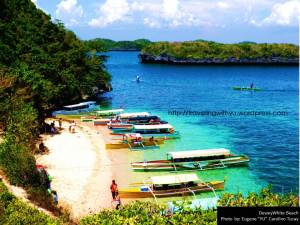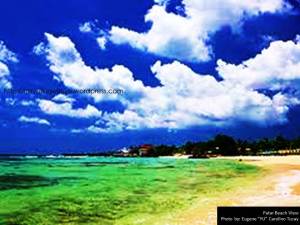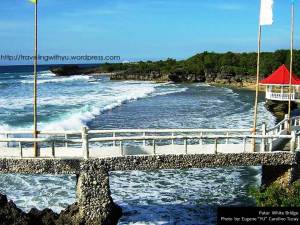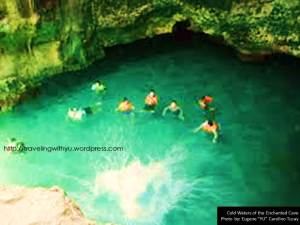“There might have been multiple crossroads you have walked by, multiple pavements you have passed by, multiple places you have gone by, but there is always a place you have most of the memories left behind which you always want to as your safe exile.” – Yu Kaito
I have been to lots of places but there is always one place I remember most of my childhood and its Bolinao, Pangasinan. As a Bolinaonon, I speak the dialect (Binobolinao) and still embody the culture, which made me write about my hometown, to give insights of what’s at stake when you visit Bolinao, Pangasinan. You know what is best from Philippines – food and beaches, which both you can have along shores of this little municipality at the tip of Pangasinan.

A beacon of light at the tip of Bolinao to guide fishermen and ships that voyage the vast South China Sea.
The hospitable municipality of Bolinao, Pangasinan or the “Hidden Jewel of the North” is known by its historical Saint James the Great Parish Church (now challenging to where the first mass happened in the Philippines instead of Limasawa) which was built around 1609 by the Agustinians, it’s delicacies like binungey or bamboo rice cake and padas or vermiculated spinefoot sauce or clear bagoong isda, fresh marine products ranging from cudincudin or sea urchins or uni in Japanese to sungayan or unicorn fish <I miss this grilled Sungayan… yum yum yum>, scenic rock formations, and beaches. The grandeur of the rock formations and clear waters suits a very tropical atmosphere. Aside from the variety of sand colours from salt and pepper, orange, yellow, and white; the amusing enchanted cave and the beacons or lighthouses are also on the must see list.
Travel: To Bolinao is a private or bus ride from Manila around 5-7 hours to north. It may be a long ride but a worthy one. The fare is around Php 400-500 from Cubao or Pasay to the Bolinao’s Poblacion and vice versa. Tricycle rides are available near the area to drive you wherever you might want to go around Bolinao.
Below are my lists of places to go as far as I could remember and will revisit soon:
Saint James the Great Parish Church – one of the oldest churches in the Philippines and Pangasinan. This Agustinian church stand along the main road of Concordia Poblacion. This shows a strong the Catholicism heritage in the province. Just in front of the church’s gate are the souvenirs and binungeys for you to try.
Bolinao Wet Market – a place I always remember where my mama or lola and I went to get some fresh produce and marine products. Here you can get a freshly caught sungayan which is very delicious after grilling.
Breakwater and El Pescador Resorts and Hotel – a short turn going to Germinal toward the sea lays a beautiful view of the vast South China Sea. You can hangout and stay at the El Pescador Resorts and Hotel and ask your sungayan to be grilled.
Guiguiwanen Channel, Subor, Cape Bolinao Lighthouse, Our Lady Fatima Hills, UP Marine Science Institute, Cueba ni Palos – this is one of the oldest beach resorts we have in Bolinao. You just need to pay for the nipa huts or cottages at a very affordable price. You might want to climb the Our Lady of Fatima Hill and pray in the chapel before you continue climbing to the Cape Bolinao Lighthouse, one of the oldest beacons we have in Pangasinan, another is in Patar. You can also go down and ask from UP Marine Science Institute to join on their trips to Silaqui Islands where giant clams were bred. From the UP Marine Science Institute building along the sea shore walk towards west and you will see the Subor or spring in English where fishes swims across the sweet water towards brackish then salty. Cueba ni Palos or Palos’ Cave is an amazing adventure. There is a legend about the cave with three entrances, which was used by Palos as a panic to keep him safe during the war. One of the entrances goes to his room and the others go to the intruder’s death place.
Pantalan, Dewey White Beach, & Balin Buaya – see the port of Bolinao and the islands separate from the mainland with the vast view of white sand and ocean, pass through a rumoured sprouting volcano, the salt factory, colourful apay or straw mats made of a family of anahaw (a round-leaf fountain palm) leaf or what local calls silag and the local weavers, maguey ropes andsinamay weavers, and the local community or the fishing village.
Long Beach and Governor’s Road Beaches – additional beaches you can explore around Bolinao where sand were white and people were so nice.
Balingasay Beach – this is a haven for local bars and fishing village along the trench of a river approaching the ocean. I remember my mom telling stories about how brackish the waters of this area and how strong the current where they used to training the swimmers’ speed as an athlete. This is where you can find the salt and pepper colour of sand where you can as well enjoy the sunset view.
Patar White Beach, Enchanted Cave, Patar Lighthouse, Rock View Beach – more beach, amazing cold waters inside a cave, another beacon of light, and the amazing Rock View Beach showing off the various rock formations.
There’s a lot more Bolinao can offer from food to adventure to soaking yourself on its beautiful beaches. If you would like to get some details on Bolinao Travel Guide, I will be creating a different link for you to look at or you can email me directly to give you some recommendations.
You can now follow me in twitter @travelingwithyu.
Related articles
- Why YU TRAVEL? (travelingwithyu.wordpress.com)
- Our Bolinao Adventure (annekralovna.wordpress.com)






No comments:
Post a Comment